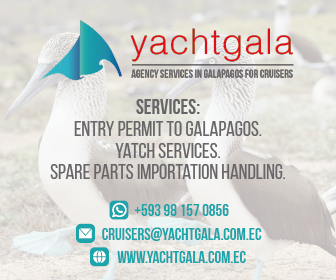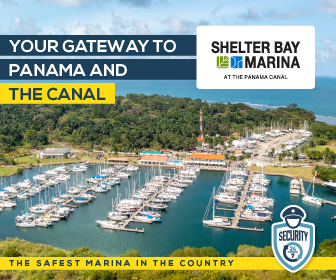Costa Rica – December 2010
Published 14 years ago, updated 6 years ago
The following information is provided to help cruisers entering and leaving Costa Rica. This information is based on two U.S.A. citizens on the 42-foot catamaran “YOLO” with no pets.
Puerto Limon located on the Caribbean Sea.
Contact “Limon Port Control” on VHF channel 14 or 16 just prior to entering the commercial port area. Limon Port Control is staffed 24/7 and only closes on Christmas and New Year’s day. The Port Control operators speak English and Spanish.
Entering the harbour is straight forward. There is plenty of deep water to the north, east, and southeast of the commercial harbour. The only offshore concern to navigation is Isla Uvita which is a small easy-to-see island northeast of the commercial harbour.
Puerto Colon is primarily a commercial port, the second largest on the Caribbean Sea in Costa Rica. It handles over 2,500 cruise and cargo ships per year. The northernmost and largest pier is called “Alamen” (we call it Pier 1). The large building on this pier contains the port authority offices. Pier 2, the next pier south of Pier 1 is very short and is used by the Coast Guard and the”Quiribri” pilot boats. Pier 3, the next pier to the south of Pier 2 is very short and is used by the large commercial tug boats. Further south are two more large commercial piers, which we call Piers 4 and 5. Pier 5, the southernmost pier is very old and is seldom used according to local fishermen and the Port Authorities.
We anchored in 30 feet of water at 09°59.352 north and 83°01.593 west in sand/mud. Great holding. This location is near shore and BETWEEN the two southernmost commercial piers, Piers 4 and 5. We had to run a line to shore to point our boat eastward into the gentle/small swells.
Clearing In
No agent is required for clearance. Call Limon Port Control on VHF Channel 14 and 16 to clear in and out of Costa Rica. Port Control will make arrangements for the six government agencies to come out to your vessel at the same time. The six agency representatives include Immigrations, Port Authority, Harbour Master, Health Department, Vegetable Quarantine official, and Meat Quarantine official. Typically, you do not have to provide transportation for these officials to your vessel. Although health is required, we never spoke to a Health Inspector.
Multiple copies of your documents are required: 5 copies of passports; 3 copies of crew list; 2 copies of the ship’s papers and a zarpe from your last port. We were asked to declare guns, ammunition, illegal drugs, foods, pets, spear guns/slings, etc. However, we did not meet with the health or quarantine officials
Upon arrival at the port, we immediately tried to clear into Costa Rica. After numerous conversations with Port Control via VHF during a two day period on board our vessel, we took our dingy ashore and walked to the Port Authority offices on Alamen Pier with hopes of clearing in. The New Year’s holiday weekend was quickly approaching and we did not want to be restricted to our vessel any longer. The Cargo Supervisor, Carlos Castro, has an office in the southeastern corner on the second floor. Carlos was very helpful and immediately called numerous officials to assist us in clearing in. Within several hours the following officials sat with us in the second-floor cafe to complete preliminary paperwork:
Immigration: Erick, home phone 8705-1553, cell phone 8875-5463
Port Authority: Nickol, phone 8366-8424
Harbour Master: Gerardo Martinez, 8367-2426
All of the above officials spoke some English, as do many of the port employees. We did not meet the health or quarantine officials. Nor, did anyone visit our vessel. This was probably due to the fact that we speak very little Spanish, the approaching holiday weekend was just around the corner, or the officials not wanting to deal with small sailing vessels.
Clearing Out
Call Limon Port Control to make arrangements to clear out. Port Control will make arrangements with Customs, Immigration, and the Harbour Master to meet you for the completion of paperwork. During our stay, we simply made arrangements to meet the Harbour Master, and he drove us to the nearby (walkable) Customs and Immigration offices.
Normal government business hours are from 08:00 to 16:00, Monday to Friday. It appears that no clearance is carried out outside these hours.
Fees
Fees can be paid in Costa Rican colones or United State dollars. During our visit, 500 colones equaled 1 U.S. dollar. Colon has numerous ATMs and they dispense U.S. dollars or Costa Rican colones.
Harbour Fee: The Harbour Master will give you a payment voucher for $50 USD during your initial meeting. You must take the voucher to a local bank and pay the related fee. At the bank, the teller would not accept U.S. dollars for payment of the voucher, which noted that the fee was “$50.00 USD.” We had to exchange $50 USD for Costa Rica colones, for a fee of $1 USD, to complete the transaction. The bank gave us a paid voucher receipt. Return the paid receipt to the Harbor Master prior to clearing out of Costa Rica.
Security
We felt that personal and property security issues were low risk at the commercial port and in Puerto Colon if common sense was used during your visit. The commercial port area has many security cameras and guards, and the entire area is blazing in lights during the night. We were advised to avoid several unsafe areas near the port. For example beyond Pier 5 and the area up the small river beyond the pier.
Goods and Services
Costa Rica is less expensive than most Caribbean islands/nations. A litre of gas was $1.15 US dollars and diesel was slightly less. A 2 litre bottle of Pepsi was $1.40, a dozen large eggs were $2.00, and a loaf of wheat bread was $2.56 USD. An extensive variety of goods and services are available within a very short walking distance. The produce was excellent in Costa Rica.
To reach the heart of the Colon business district walk out of the commercial port pedestrian gate located just north of Pier 5, travel one block north and turn left. PALI (Walmart), Pizza Hut, Burger King, and numerous banks, restaurants, retail stores, open markets, over-night couriers, gas stations, bus stations, casinos, and grocery stores are located within the Colon business district.
Potable water: You can drink the tap water in Costa Rica. The port employees on Pier 2 and 3 stated, “use our hoses and take as much water as you want.” Only Piers 2 and 3 appeared to have water faucets.
Garbage: Use the large trash drums located at the end of Pier 3.
Other Information
We got the impression that very few yachts visit Puerto Limon or Puerto De Moin, Costa Rica.
Most merchants are eager to accept U.S. Dollars and many accept MasterCard or VISA. Only one merchant tried to charge us an exchange rate fee, of 23%!
Per the instructions of the port employees on Piers 2 and 3, we used these piers as dingy docks. Most of the time we tied our dingy to “Quiribri” on Pier 2 when the pilot boat was not being used.
Cruise ships typically use the Piers 1 and 4, one day per week. During our visit, there were three cruise ships in port on the same day. Puerto Limon is a good location to escape weather coming in from the south, west or north. You might want to move your vessel to Puerto De Moin if strong wind or waves are from the east. Puerto De Moin is the largest Costa Rician commercial port on the Caribbean Sea, and it is located several miles west of Puerto Limon.
The Port Authorities and Harbour Master did not recommend anchoring south of Pier 5, for four reasons. 1. This small anchorage area is close to the Rio Cieneguita, a river which is used by numerous high-speed fishing boats. 2. The Rio Cieneguita and city of Cieneguita are high-risk security areas for visitors. 3. There are at least four sunk vessels in the area (2 near shore, 1 just south of Pier 5, and 1 southeast of the red buoy marking the approach to the Rio Cieneguita. 4. This anchorage area is 16 feet deep with good holding, yet this corner of the harbor is typically exposed to more wind, waves, and swell.
During our brief stay in late December and early January, it rained late in the afternoon every day. It is believed that the high mountains to the south and west of the port helped create near windless conditions most of the time.
Jason and Karen Trautz
S/V “YOLO” (You Only Live Once)
Related to following destinations: Costa Rica







